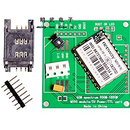Introduction: GSM Tracker for Car Localization
What is it all about?
This project is a cheap solution to install a car or bike tracking gadget. I made it to make sure I can always get the position of my car in case of it gets stolen.
How does it work?
You have basically two choices to get position data: have a GSM or a GPS tracking tool.
- GPS is much more precise (1-5 meters), but requires a clear view to the sky (and to at least 4 satellites at the same time).
- GSM is far less accurate (about 50-200 meters in urban area), requires an active SIM card (subscription to a mobile provider), but can operate almost anywhere, even in underground garages or inside buildings - as far as there is GSM signal. (Even a very poor signal will ensure the operation.)
Also, GSM localizators are cheaper than GPS trackers. I am using a GSM tracker in this project (don't let you trick the GPS letters on its cover), because I was looking for a budget solution, and already had a SIM card at my hands. Once you have your GSM/GPS tracker, you have to find a way to power it and to install it into your vehicle.
How to install it into the car?
These types of tracking tools usually powered with 5V DC, connected to a USB socket. So you can buy a 12V to 5V DC-DC converter with an USB plug (such this one), or vote to the DIY way and build a little circuit to get the stabilized 5V required by the tracker.
After you have your power supply ready you just need to connect it to your vehicle's battery and hide your tracker somewhere inside the car.
How to use it?
The actual model I have can be requested for its position by sending a SMS, and provides its position data within 30 seconds by a response SMS. Easy way, indeed.
The GSM tracker I use has no GPS chip inside. It can locate itself by triangles the nearest cell phone towers. It's best precision is about 50 meters, probably more. You can request the position by sending a special SMS to the SIM card, and after a while you will get a response SMS with a link. The link looks something like this:
http: //www.gps588.com/lbs/?mcc=111&mnc=111&lac=1111&cellid=111
(The 111-s are for demonstration only, the actual numbers defines the position of the tracker.)
Now, that link is rather useless, but you can harvest the codes from the URL to take advantage of this site: http://www.minigps.net/map.html
This site requires you the type the MCC, MNC, LAC and cell ID values harvested from the SMS the tracker sent to you. Using that values the site indicates the position on a map.
Is it accurate?
Not really. A GSM tracker is able to designate a 50-250m radius. Your tracker is somewhere within.
This is a poor localizator, you may say. It is. But it is far more accurate than the police, in case your car has stolen. They won't have a glue where to look for your car - but with a tracker you will have some information.
If you need more precision, use a real GPS tracker rather than a GSM tracker. Or use both, as GPS may not work in certain conditions where a GSM tracker is still operating.
You can read more about LBS positioning (used by GSM trackers) here.
Step 1: Building a Power Supply
What components you will need?
The easy way
In a nutshell: buy a prebuilt DC-DC converter, connect to your tracker and to your battery, optionally case it into a project box - and you are ready.
The fun way
If you choose to build your own DC to DC converter, than you will need some stuff:
- tracking gadget of you choice, of course. I bought this model.
- a little piece of PCB board
- 5V voltage regulator
- DC power connector (any type - I used a 5.5x2.1 mm PCB connector)
- 80-120 Ω, 0.5W resistor
- some thin wire
- some kind of fuse and fuse holder
- a project box to house your tracker and power supply board
Optionally you will need:
- 2 capacitors: 10 μF and 100 nF
- semiconductor diodes
Capacitors are optional in this configuration as the tracker I using has a built-in charge controller, which would tolerate the slightly instable voltage levels the voltage regulator can provide without condensators. Anyhow, I chose to use the properly sized capacitors as there was enough place for them in the project box.
Semiconductor diodes are placed into the circuit for one reason: securing the circuit. One of them is protecting the voltage regulator and the Li-ion battery from reverse voltage. This can easily occur if you connect the power supply cables to the car's battery with reverse polarity. With the diode in place the circuit will not get destroyed by reverse current, but can not charge the Li-ion battery, of course.
The other diode is to block current leaking from the Li-battery towards the charger circuit. As the battery is a 500 mA power source it would get depleted in a very short time without the diode when your power supply is disconnected from the car battery.
Using a resistor is vital, as it will save your circuit from burning away. Without a resistor the current flowing through your components will be way too high. First I used a single 220 Ω resistor, and it was great - until I inserted the semiconductor diode between ground and the resistor to secure the circuit against reverse polarity. With the diode's voltage drop the voltage regulator did not got high enough voltage anymore and the 3.7V Li-ion batteries can not get fully charged. So I soldered one more, 120 Ω resistor in parallel with the 220 Ω resistor to get about 80 ohms resistance. With this the Li-ion battery was able to charge fully.
(You can calculate parallel resistors final resistance with this calculator.)
Ensure that you utilise some type of fuse. You really do not want to fire your car, so use a fuse regardless there is nothing potentially dangerous in this circuit. The project box may get soaked by rain water, short circuit can occur - so safety first, use a fuse!
What tools do you need?
Just have a soldering iron and optionally crimping pliers. Some glue also will come in handy to fix the power connector into your project box. A drill is needed to make a hole into the box for the power connector.
That's all about tools.
Step 2: Voltage Regulator Choices
There are basically two types of voltage regulators: switching regulators and linear regulators.
For this kind of application (the regulator is installed into a little, closed box without any ventilation) switching mode regulator is the right choice. I used a small scale type (in SOT223 packaging) to use as little space as possible.
This type of regulators dissipate very little amount of heat - no heat sink is required. Switching regulators uses PWM (power with modulation) as a method to switch on/off power source at a high frequency to provide the required level of output voltage.
On the other hand, linear regulators dissipate heat derive from voltage difference between input voltage (12-14V) and output voltage (5V). In a car you really don't want to use something that gets hot like fire. Linear regulators are not the way we are looking for in this project.
Using voltage regulator IC-s are easy. I do not provide details about it - even the product's datasheet contains schematic.
Step 3: Finishing the Tracker Box
After you built your circuit board, connect it's 5V output to the GSM tracker's battery contacts. To be more precise: you need to connect your 5V wires to the built-in charge controller. I've done this with soldering.
You're just one step away: drill a hole into the project box to the power connector, and fix the female connector to the box with some glue.
Now you can close the box, and connect the 12V connector. Anyhow, your inner parts are probably shaking inside the box. They need some fixing. For this purpose I simply cut a piece of kitchen sponge and inserted into the box, along with the tracker and the power regulator circuit. It did the trick.
Now the final step: find a good, hidden place inside your vehicle, where your little, matte, black box is not flashy for the curious eyes. You need a place where GSM (or GPS) signals can reach your box.
I placed my box inside the hollow of the windshield wiper arms. I don't think anyone will ever find it.
I have my box installed for about six months now. It works without any interaction, no maintainance needed. I used to send an SMS to the tracker every week or so, to see if it is still working great. (It does.) So I have a higher level of peace of mind since I know I do have a tracker in my car, if I need to locate it.











